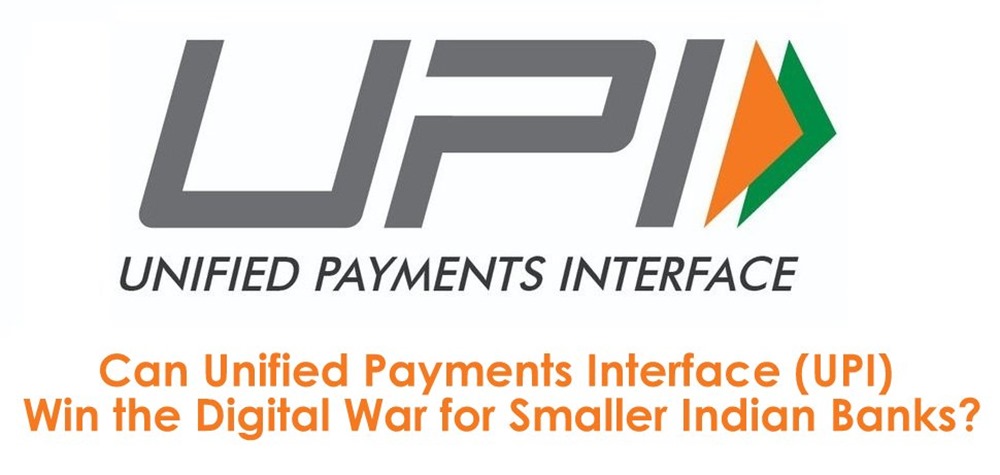Can Unified Payments Interface (UPI) Win the Digital War for Smaller Indian Banks?
Digital payments solutions such as Unified Payments Interface (UPI), National Unified USSD Platform (NUUP), and Aadhar for identity and eKYC have the power to attract customers towards digital banking platforms.

Banking and financial services in India remained impervious to technological changes for a long time. There have been innovations in internet and mobile banking, but the span of adoption has been limited. This is clearly not enough in recent times. With the advent of disruptive technologies like mobile wallets, advanced POS devices, NFC and biometric based payment methods, banks need to grow beyond skin deep innovation.
In fact, the recent demonetization drive has created a need for banks to assume a bigger and diversified role for its consumers. Most of the larger banks have responded quickly to the paradigm shifts in retail payments and have already begun to fully integrate digital technologies. But what about smaller and new generation banks? How do we bring them up to speed in the cut throat competition amongst wallet companies and other financial entities with deep pockets? Gone are the days when loan and insurance used to be the major use cases in retail banking.
India has begun moving towards digitization and banking is the next frontier that will witness digital disruption. Herein lies the opportunity for small and next generation banks to capitalize on cutting edge innovations – solutions such as Unified Payments Interface (UPI), National Unified USSD Platform (NUUP), and Aadhar for identity and eKYC have the power to attract customers towards digital banking platforms.
Contents
UPI- A Game Changer
UPI (Unified Payment Interface) presents an opportunity to change the retail banking ecosystem. Between Aug 2016 and March 2017, UPI transaction volume has increased from approx. 93,000 to 49, 00,000 and transaction values from approx. INR 3.1 Crore to INR 1970 Crore. This shows the growing consumer confidence in UPI. The biggest advantage of UPI is that it brings mobile based payments to customers of small banks, which don’t have mobile application based banking facilities. The real power of UPI would blossom when account holders in rural India would start using UPI based applications such as BHIM or USSD services like NUUP to transact using their bank accounts.
Addressing Customers’ Problems
The right adoption of UPI can give small banks an edge over mobile wallets. UPI can solve major payment problems, bringing ease of usage, security and interoperability. A fully operational UPI is a win-win – for banks, customers and overall ecosystem. It will create a level-playing field for small banks struggling to catch up with easy-to-use, seamless technologies of mobile wallets and the onslaught of non-traditional banking services on their transaction businesses.
Enabling Innovation
Small banks need innovative thinking. For a small bank to launch mobile banking, they would require investments which might not be justified given the smaller user base. This has caused many small banks to have basic, run off the mill mobile offerings that have not seen much success in the market. Marketing these offerings are an additional overhead financially which means that more often than not, the customer is not even aware of the existence of such an offering. With UPI and NUUP coming to the forefront, many of these limitations can be addressed.
With the launch of BHIM and the concerted government push through multiple marketing channels such as Television Ads and Radio in the native languages, more and more of the masses are becoming aware of UPI. All that smaller banks need to do is educate their customers on how to use these channels without having to invest in additional technology or operations. Peer to peer learning can then take over to get the masses to adopt mobile as the primary channel for banking.
Transforming Digital Banking
As per Boston Consulting Group (BCG) and Google report, payments through digital instruments in India could increase by about a factor of 10 by 2020. Also, continuing the digitization push, the government is setting up a mission to promote cashless transactions with a target of touching 2,500 crore transactions in the year 2017-18. Banks must leverage these opportunities to take digital banking to new levels utilizing emerging services like UPI and NUUP, setting up new definitions of customer experience. That’s the winning formula.
About the Author: The article is contributed by Manoranjan ‘Mao’ Mohapatra, CEO, Mahindra Comviva
